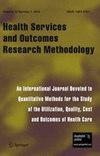检查护理质量:CUSUM方法对医院间绩效的比较
IF 1.6
Q3 HEALTH CARE SCIENCES & SERVICES
Health Services and Outcomes Research Methodology
Pub Date : 2023-10-24
DOI:10.1007/s10742-023-00315-0
引用次数: 0
摘要
在过去的14年里,临床审计已经在荷兰使用,为医院提供他们在结肠直肠癌护理方面的表现数据。对每家医院提供的护理质量的持续反馈对于改善患者的治疗效果至关重要。目前尚不清楚应该使用哪种方法来产生最具信息量的输出,以识别潜在的质量问题。我们的目的是比较常用的漏斗图和现有的累积和(CUSUM)方法,以评估荷兰接受结直肠手术患者的术后生存和住院结果。荷兰结直肠癌审计的数据来自荷兰71家医院2019年至2021年期间接受结直肠癌手术切除的25367名患者,用于比较四种检测护理质量偏差的方法。考虑了基于二元结果的两种方法(漏斗图,二进制CUSUM)和基于生存结果的两种CUSUM图(BK-CUSUM和CGR-CUSUM)。提出了一种确定医院特定控制范围的新方法。对四种方法的检测偏差的能力以及检测时间进行了比较。制作图表,检查术后生存和住院时间。与采用二进制结果的方法相比,使用生存结果的方法总是产生更快的检测时间。两种方法的检测结果在术后生存率上基本一致。对于住院时间的检测差异很大,基于生存结果的方法显示了超过一半的医院。讨论了所有考虑的方法的进一步优点和缺点以及缺陷。持续检查护理质量的方法应根据具体结果进行调整。正确理解控制图的作用机制对于正确解释结果至关重要。对于CUSUM图表来说尤其如此,它需要选择一个对结果影响很大的参数。在应用CUSUM图表时,强烈建议考虑这些问题。本文章由计算机程序翻译,如有差异,请以英文原文为准。
Inspecting the quality of care: a comparison of CUSUM methods for inter hospital performance
Abstract During the past 14 years, a clinical audit has been used in the Netherlands to provide hospitals with data on their performance in colorectal cancer care. Continuous feedback on the quality of care provided at each hospital is essential to improve patient outcomes. It is unclear which methods should be used to generate most informative output for the identification of potential quality issues. Our aim is to compare the commonly employed funnel plot with existing cumulative sum (CUSUM) methodology for the evaluation of postoperative survival and hospital stay outcomes of patients who underwent colorectal surgery in the Netherlands. Data from the Dutch ColoRectal Audit on 25367 patients in the Netherlands who underwent surgical resection for colorectal cancer in 71 hospitals between 2019 and 2021 is used to compare four methods for the detection of deviations in the quality of care. Two methods based on binary outcomes (funnel plot, binary CUSUM) and two CUSUM charts based on survival outcomes (BK-CUSUM and CGR-CUSUM) are considered. A novel approach for determining hospital specific control limits for CUSUM charts is proposed. The ability to detect deviations as well as the time until detection are compared for the four methods. Charts were constructed for the inspection of both postoperative survival and hospital stay. Methods using survival outcomes always yielded faster detection times compared to approaches employing binary outcomes. Detections between methods mostly coincided for postoperative survival. For hospital stay detections varied strongly, with methods based on survival outcomes signalling over half the hospitals. Further pros and cons as well as pitfalls of all methods under consideration are discussed. Methodology for the continuous inspection of the quality of care should be tailored to the specific outcome. Properly understanding how the mechanism of a control chart functions is crucial for the correct interpretation of results. This is particularly true for CUSUM charts, which require the choice of a parameter that greatly influences the results. When applying CUSUM charts, consideration of these issues is strongly recommended.
求助全文
通过发布文献求助,成功后即可免费获取论文全文。
去求助
来源期刊

Health Services and Outcomes Research Methodology
HEALTH CARE SCIENCES & SERVICES-
CiteScore
3.40
自引率
6.70%
发文量
28
期刊介绍:
The journal reflects the multidisciplinary nature of the field of health services and outcomes research. It addresses the needs of multiple, interlocking communities, including methodologists in statistics, econometrics, social and behavioral sciences; designers and analysts of health policy and health services research projects; and health care providers and policy makers who need to properly understand and evaluate the results of published research. The journal strives to enhance the level of methodologic rigor in health services and outcomes research and contributes to the development of methodologic standards in the field. In pursuing its main objective, the journal also provides a meeting ground for researchers from a number of traditional disciplines and fosters the development of new quantitative, qualitative, and mixed methods by statisticians, econometricians, health services researchers, and methodologists in other fields. Health Services and Outcomes Research Methodology publishes: Research papers on quantitative, qualitative, and mixed methods; Case Studies describing applications of quantitative and qualitative methodology in health services and outcomes research; Review Articles synthesizing and popularizing methodologic developments; Tutorials; Articles on computational issues and software reviews; Book reviews; and Notices. Special issues will be devoted to papers presented at important workshops and conferences.
 求助内容:
求助内容: 应助结果提醒方式:
应助结果提醒方式:


